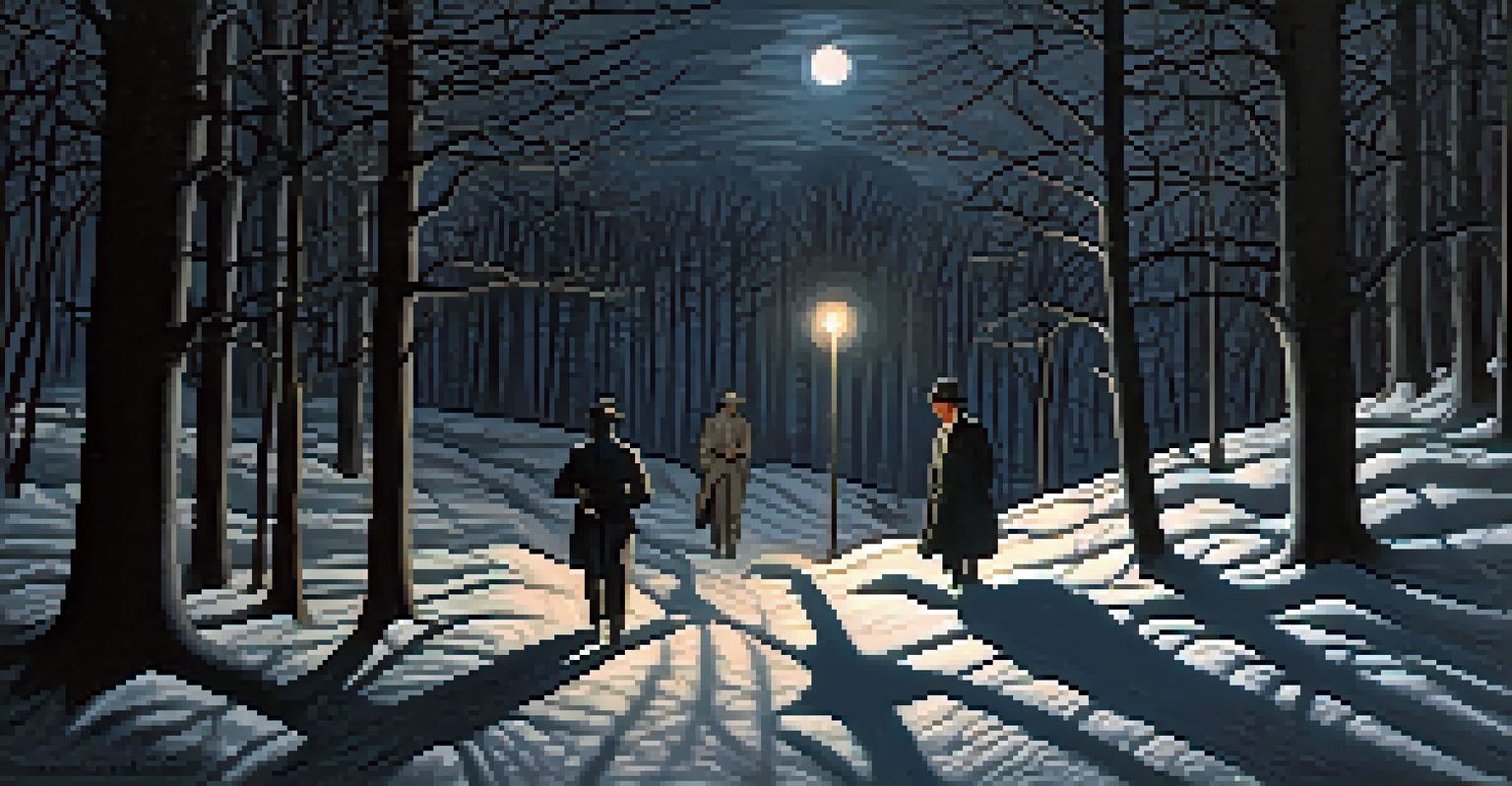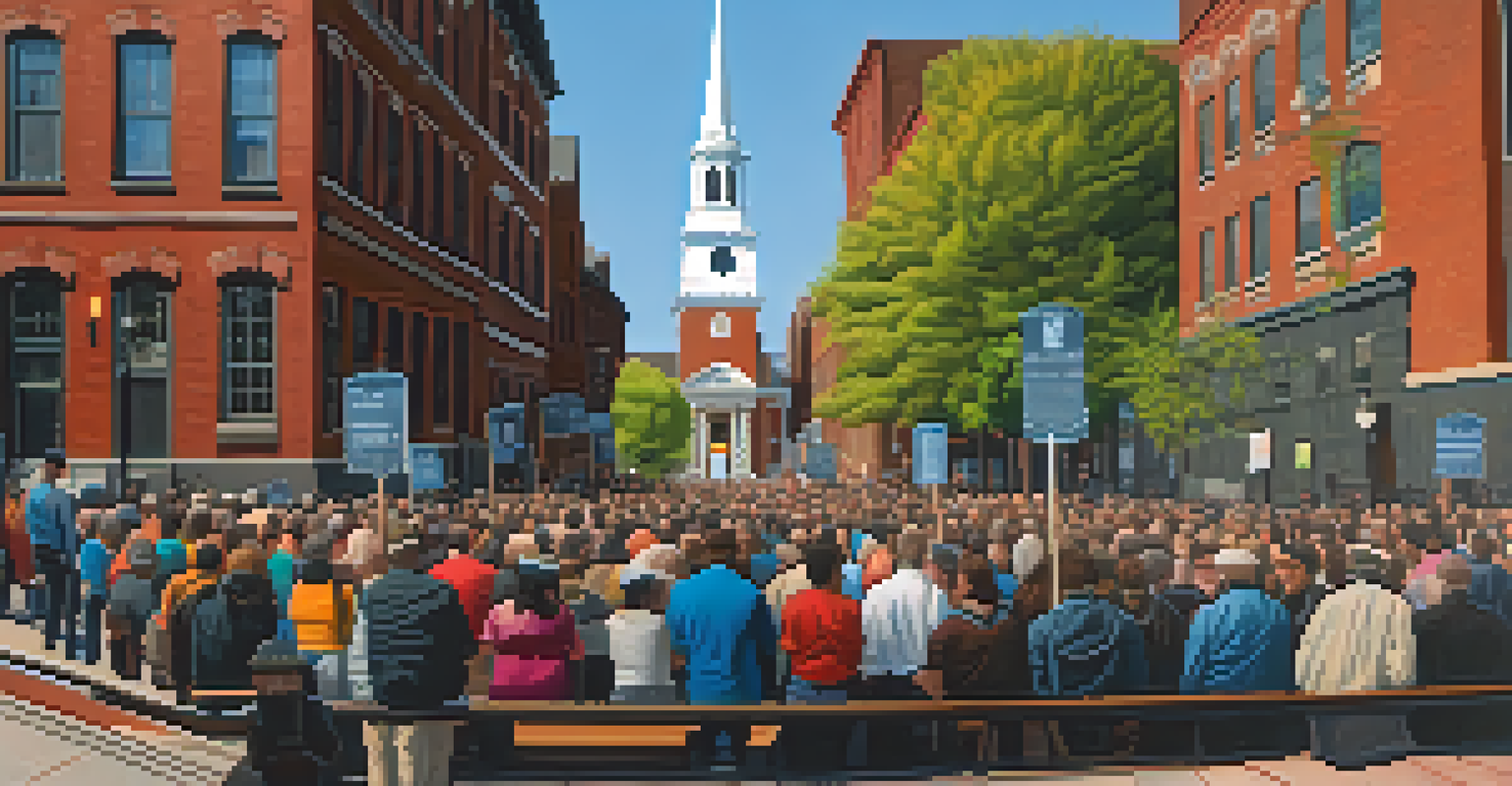Boston's Underground Railroad: A Path to Freedom

The Historical Context of Boston's Role
In the early 19th century, Boston emerged as a critical hub for the Underground Railroad, a network designed to help enslaved people escape to freedom. The city was strategically located near the northern border of the United States, making it a vital stop for freedom seekers. Many abolitionists in Boston were inspired by the ideals of liberty and equality, which fueled their commitment to the cause.
The best way to find yourself is to lose yourself in the service of others.
The Fugitive Slave Act of 1850 heightened tensions, as it compelled citizens to assist in the capture of runaway slaves. In response, Boston's abolitionist community became even more resolute, seeking ways to protect and shelter those fleeing bondage. This act created a sense of urgency, uniting many residents in the fight against slavery.
Prominent figures like Frederick Douglass and William Lloyd Garrison rallied support in Boston, drawing attention to the plight of those seeking freedom. Their efforts helped to establish the city as a beacon of hope amidst the darkness of slavery, forever altering its historical landscape.
Key Sites of the Underground Railroad in Boston
Boston was home to several significant locations that played crucial roles in the Underground Railroad. One such site is the African Meeting House, built in 1806, which served as a gathering place for abolitionists and freedom seekers alike. This historic venue hosted meetings and events that galvanized community support for the cause.

Another important landmark is the home of Lewis and Harriet Hayden, former enslaved people who became prominent abolitionists. Their residence was a safe haven where fugitives could rest and regroup before continuing their journey northward. The Haydens' unwavering commitment to aiding others exemplified the spirit of solidarity among the abolitionist community.
Boston's Key Role in Underground Railroad
In the 19th century, Boston emerged as a crucial hub for the Underground Railroad, providing shelter and support for freedom seekers escaping slavery.
The Old North Church, famous for its role in the American Revolution, also became a symbol of hope during this era. It served as a meeting point for those involved in the Underground Railroad, bridging the past with the ongoing struggle for freedom. These sites remind us of the bravery and resilience that characterized Boston's fight against slavery.
The Role of Abolitionists and Allies
Abolitionists in Boston played a pivotal role in shaping the Underground Railroad. They were not just activists; many were also allies who opened their homes and hearts to provide refuge. This collaborative spirit fostered a network of support that was crucial in helping enslaved individuals navigate their path to freedom.
Injustice anywhere is a threat to justice everywhere.
People from various backgrounds, including white and Black citizens, joined forces to combat the injustice of slavery. Their commitment was often met with danger, as they risked legal repercussions and social ostracism. Yet, their steadfast determination to aid others demonstrates the power of collective action in the face of adversity.
Notable abolitionists like Wendell Phillips and Maria Weston Chapman organized fundraising efforts and awareness campaigns to support the cause. Their tireless work not only offered immediate assistance but also inspired future generations to continue the fight for equality and justice.
Personal Stories of Escape and Courage
The stories of those who escaped slavery through the Underground Railroad are both harrowing and inspiring. Many individuals undertook perilous journeys, often traveling at night and relying on the kindness of strangers. Each story is unique, yet they share a common thread of courage and hope in the pursuit of freedom.
For instance, Ellen and William Craft famously disguised themselves as a white man and his servant to escape from Georgia. Their daring journey took them through various states, ultimately leading them to Boston, where they found refuge among the abolitionist community. Their story exemplifies the lengths to which people would go to seize their liberty.
Abolitionists United for Change
Boston's abolitionists, including figures like Frederick Douglass, demonstrated collective action and bravery in their fight against slavery.
These personal narratives are crucial for understanding the emotional and physical challenges faced by freedom seekers. They remind us that the fight for freedom was not just a political struggle, but also deeply personal, marked by moments of bravery and resilience.
Challenges Faced by Freedom Seekers
While Boston offered hope, the journey for many freedom seekers was fraught with challenges. The constant threat of capture loomed large, especially with the enforcement of the Fugitive Slave Act. Enslaved individuals had to navigate a landscape filled with dangers, including bounty hunters and hostile locals.
Additionally, the social climate in Boston was not uniformly supportive. Some residents opposed the abolitionist movement, leading to confrontations and violence. Freedom seekers had to rely on their wits and the goodwill of allies to find safety amidst the tension.
These challenges highlight the resilience of those who sought freedom. Many individuals demonstrated remarkable resourcefulness, using their skills and knowledge of the land to evade capture and make their way toward liberation.
The Legacy of Boston's Underground Railroad
The legacy of Boston's Underground Railroad is woven into the fabric of the city’s history. The bravery of those involved laid the groundwork for future civil rights movements and continues to inspire activists today. Their efforts remind us that the fight for justice is ongoing and requires collective action.
In recent years, Boston has sought to commemorate this important chapter in its history through various initiatives, including educational programs and historical markers. These efforts aim to honor the sacrifices made by countless individuals who fought for freedom and equality.
Legacy of Courage and Resistance
The legacy of Boston's involvement in the Underground Railroad continues to inspire modern movements for social justice and equality.
Understanding this legacy is essential for recognizing the progress made and the work still needed in the pursuit of social justice. Boston's role in the Underground Railroad serves as a powerful reminder that every action, no matter how small, can contribute to meaningful change.
Modern Reflections on Freedom and Justice
As we reflect on Boston's role in the Underground Railroad, it is important to consider what freedom and justice mean today. The fight against systemic racism and inequality continues, echoing the struggles of those who came before us. Modern movements for social justice draw inspiration from the courage displayed during this crucial period in history.
Community engagement and activism remain vital in addressing contemporary issues. Just as abolitionists united to combat slavery, today's activists work together to challenge injustices in society. Their efforts remind us that collective action remains a powerful force for change.

By exploring Boston's historical significance in the Underground Railroad, we not only honor the past but also empower ourselves to create a more just future. It is a call to action for all of us to continue the fight for freedom and equality in our communities.